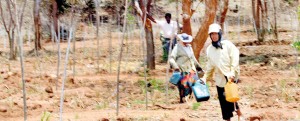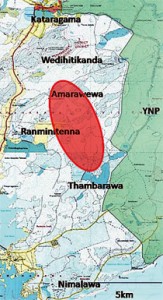News
Power from gliricidia project in Yala alarms nature lovers
Will “green energy” be produced after destroying valuable forest cover at Amarawewa adjacent to the Yala National Park, is the rallying cry of environmentalists who have taken up arms against a major project to grow gliricidia in the midst of elephant, bear and leopard country in the South.

Attending to a nursery of gliricidia
With growing concerns over the serious repercussions of clearing forest cover, moves are underway by environmentalists to seek justice in court shortly, the Sunday Times understands.
On learning of the threats and wide-ranging impact of the gliricidia project, the Environmental Foundation Limited (EFL) which visited the area adjacent to Block 1 of the Yala National Park had found that while a large swathe had been bulldozed, moves ar underway to expand the denudation to the Thambarawa-Banduwewa areas.
“The clearing of many hundred hectares was being done by United Dendro Energy (Pvt) Ltd., owned by Lanka Orix Leasing Company (LOLC),” said EFL’s Head of Operations and Environmental Scientist, Vimukthi Weeratunga, pointing out that according to the information gathered, Dendro Energy is hoping to generate electricity (green energy) from gliricidia (Gliricidia sepium) which is a fuel-wood.
Stressing that destroying the forest clearly goes against the grain of dendro-power production principles, he said that the project to grow gliricidia in Amarawewa and its vicinity for a power plant far away in Biyagama seems more like a large-scale commercial project to make money under the name of sustainable energy production.
Citing the violation of not only the National Environment Act (NEA) but also the Forest Ordinance and the Fauna and Flora Protection Ordinance (FPPO), Mr. Weeratunga underscored that the gliricidia project is being implemented illegally and continues to violate the laws. The illegal clearing of forests for permanent cultivations will harm both plants and animals and exacerbate the human-elephant conflict (HEC), he said.
The Sunday Times learns that the saga began with the Forest Department issuing a ‘Vivida avasara pathrayak’ (miscellaneous permit) to an organization of dairy farmers to use 500 hectares (about 1,250 acres) for their cattle, without harming the forest. This is under Stage 1 of the project which is to be expanded later to cover 1,500 hectares. Subsequently, the Forest Department, it is learnt, had signed a memorandum of understanding (MOU), not only with the dairy farmers but also with Dendro Energy to develop the area.
When asked, a high-level official of the Forest Department was quick to deny that the “forest is being cleared” for gliricidia cultivations. Pointing out that only the miscellaneous permit is a legal document, he said that the MOU is not. It is just an agreement the Forest Department has with the dairy farmers, Dendro Energy and another party, the latter two only to give “technical support” to the farmers.

Fig. 1. Map of area 1:50,000 topo sheet. Area supposedly being cleared shown by red oval.
Explaining the background, he said that these “grasslands” were given to dairy farmers so that they could allow their cattle to graze. The dairy farmers could either let the cattle graze on the already available grass or grow grass to “cut and feed” them. The dairy farmers then wanted to seek the help of Dendro Energy to improve their grass cultivations. So there will be grass as well as a “nurse crop” in the form of gliricidia, the leaves of which would be fodder for the cattle, while the stems would be given to Dendro Energy to produce power.
“There is no clearing of the forest,” the official said, adding that such development was only on an extent less than 100 hectares and also only “thorn forest”. He was adamant that there was no need for an EIA, insisting that the Forest Department’s deal was with the dairy farmers.
When questioned about the clearing of katu-andara (Dichrostachys cinerea), relished by elephants, with Dendro Energy being unable to transport it anywhere due to the laws of the land, he said he had no knowledge of this.
Asked about how, due to these activities, the aggravated HEC would be tackled, as animals would crossover from the Yala National Park, he said the project people would have to face the risks, but not harm the elephants.
A Dendro Energy spokesperson, however, was of the view that the MOU they signed with the Forest Department is legal. “Everything is done in a proper manner,” he assured, requesting the Sunday Times to get all the details from the Head of Dendro Energy who was out of the country and would return only today.
Denying that Dendro Energy was clearing katu-andara, he claimed that only clearing invasives such as kalapu-andara (Prosopis juliflora) were being cleared.
With the Forest Department seemingly abrogating its duty to protect forest cover, conservationists say it is ironic that a forest, which harbours many species of fauna and flora, is being bulldozed to produce so-called “green” energy.
Meanwhile, EFL is making ready to go to court over this issue.
| Gliricidia cultivations act as buffer between man and beast |
| The area where large-scale cultivations are planned is important as a “buffer” against the human-elephant conflict as it prevents elephants from the Protected Areas coming into developed areas or those where people live, reiterated the Chairman of the Centre for Conservation and Research, Prithiviraj Fernando.Referring specifically to the impact such a project would have on the human-elephant conflict (HEC), he said the area supports both herds of elephants and single adult males, some of whom spend part of the year in the area and part of the year in the adjoining Protected Areas of the Yala National Park and the Katagamuwa and Kataragama Sanctuaries.
The area is contiguous with the Protected Areas and the animals will not know the “boundaries” drawn by humans, it is learnt. According to Dr. Fernando, this area plays a more important role during the dry season as elephants forage here due to fallow and abandoned chenas which have created a habitat mosaic with an enormous amount of elephant fodder, when compared to the mature habitat in the Protected Areas. He said that every year, young elephants die during the dry season because the Department of Wildlife Conservation (DWC) put up a fence in attempts to contain elephants to DWC areas sometime ago and also closed the waterways through which they accessed the Forest Department jungles. This has resulted in Yala elephants losing a couple of generations but it is still not too late to reverse this trend. However, large-scale clearing of the Forest Department area for permanent cultivations will be the last nail in the coffin of the Yala elephants. Moving away from elephants, this scientist said the other species of mammals in the area include the leopard, sloth bear, spotted deer, sambur, mouse deer, jungle cat, fishing cat, rusty spotted cat, small Indian civet, common palm civet, porcupine, pangolin, toque macaque, grey langur, bats and shrews and numerous are the birds sighted in the area. |
| Project has violated law |
| This project is in violation of the law, said environmental lawyer Jagath Gunawardena, referring to the National Environmental Act’s Section 23 AA and BB which stipulate that any such ‘prescribed project’ has to get approval from the project-approving agency and the Central Environmental Authority (CEA).Gazette No. 772/22 of June 24, 1993 lists the ‘prescribed projects’ and one type is the conversion of a forest land exceeding one hectare to non-forest use, he says, adding that cultivation of more than 50 hectares of land that is not a forest also falls under a ‘prescribed project’.
Either way, an environmental impact assessment (EIA) is mandatory, according to Mr. Gunawardena, and if a project starts without an EIA, the CEA can issue a directive under NEA’s Section 24 B Sub-section 1 to halt all activities of the project immediately until approval is obtained. If the directive is not heeded, the CEA can get a court order to stop the project, he added. |
Follow @timesonlinelk
comments powered by Disqus


























